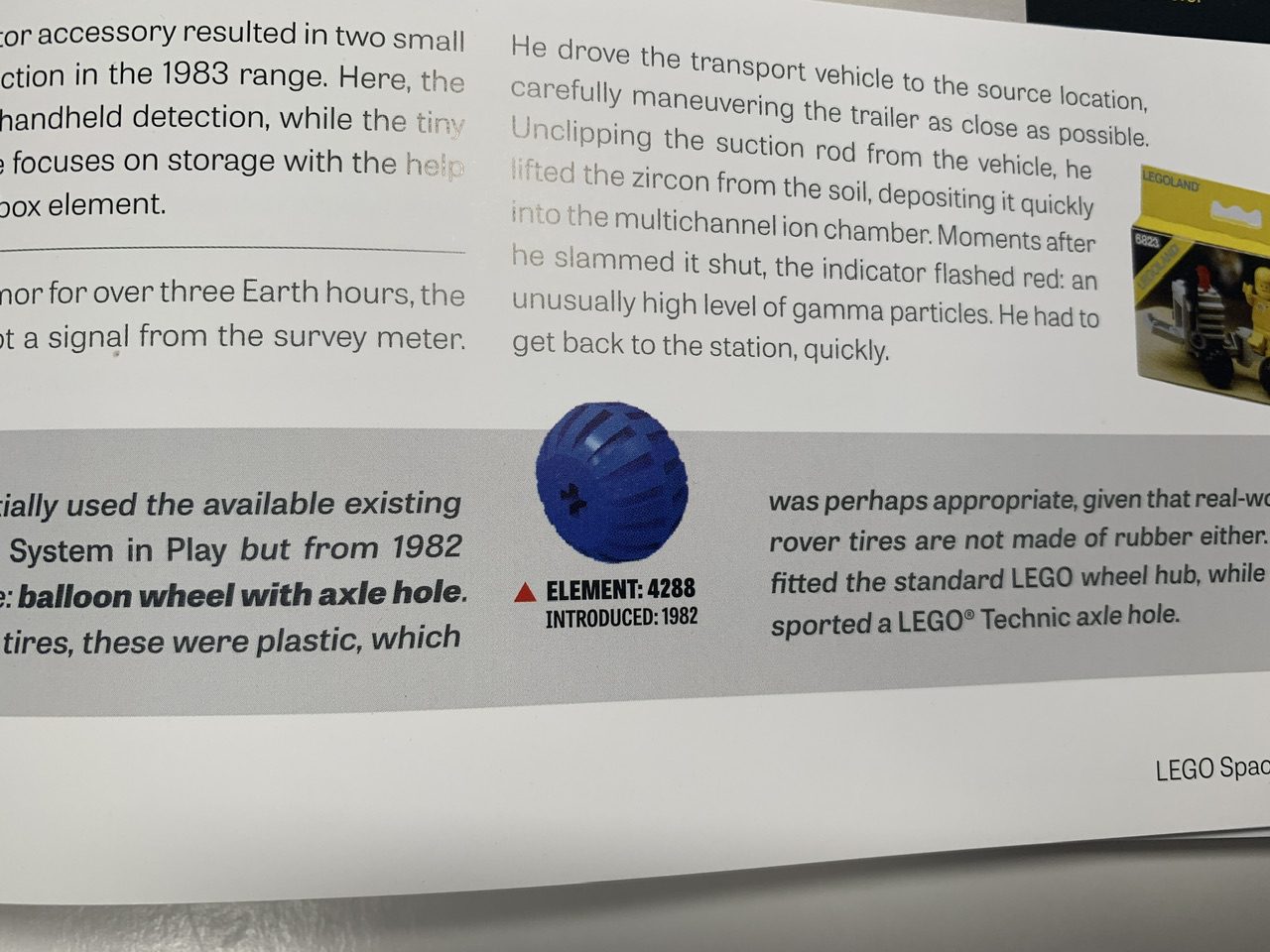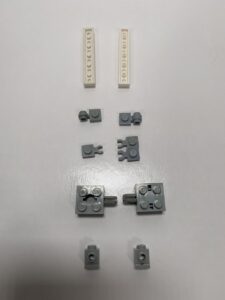Lego Classic Space collecting information

Introduction and overview of the Lego Classic Space theme
Here you will find an overview of the most importent Lego Classic Space collecting information. Lego Classic Space is a series of lego models that is clearly marked in time and is about the sets from 1978 – 1987, spanning a cool decade. Also easily pinpointed by to use of the ONE COLOR spacemen / astronauts. The 5 types of Classic Space Men contain the white and red spaceman, accompanied by the little later introduction of yellow and blue and the last color is black, these classic spacemen / astronauts where found only in the last sets. Below shows how Lego showcased the Lego Classic Space set in 1982.

The Classic Space series has it all, which adds up to a total just over 70 different sets (you can find a list of all lego classic space sets on several websites). Starting with small spaceships and 4-wheeled vehicles, the theme developed and elaborated in bigger and bigger space ships, space bases with rail transport to the ship launcher with as much as 4 minifigs. There were also droids (robots) small and large as well as vehicles with specific purposes like mineral gathering, a mobile rocket launcher and a solar power transporter.
Most importantly, there were no weapons! Yes there were rockets and specific utensils for the minifigs to use but no Classic Spaceman ever shot, harmed or killed a fellow Classic Space astronaut. In Lego Classic Space, astronauts travelled the galaxy, from moon to planet, colonizing, exploring, mining and transporting for as far as your imagination could take you. Another reason to draw the line at 1987 because after that, space police and different factions emerge to be added to a near perfect world.
From ordinary lego to Lego Classic Space
LEGO Classic Space fell under the LEGOLAND theme. The Lego Classic Space sets were a leap forward in Lego design. Compared to the Lego Company’s earlier introductions of a few space themed sets, this complete new series had a lot of new parts and the incorporation of new techniques not previously used. Although a good selection of the basic building blocks were used, there were now parts with finer details, specially created for this series to make more smooth looking ships and multi-purpose vehicles.
Special lego elements that make lego classic space
Below a picture out of the “Lego space book 1978-1992” (see below), showing the space wheel. This book covers all the unique elements used for the first time in this game changing range for Lego, more on this book later on.
A few that come to mind right away are the specially printed parts for this series. Basic parts like bricks and slopes got a special space logo. When a set is missing this special element, it is just not correct. The classic space series also needed parts that made ships into space ships and cars into moon buggies. So here was a need for wings, space stands, thruster and balloon wheels. For communication we needed antennas and even better a whole lot of transparant parts. Some of these shown below, borrowed from the great catalog on brickowl.com. That shows you almost exactly what element goes where and in which sets it was used.
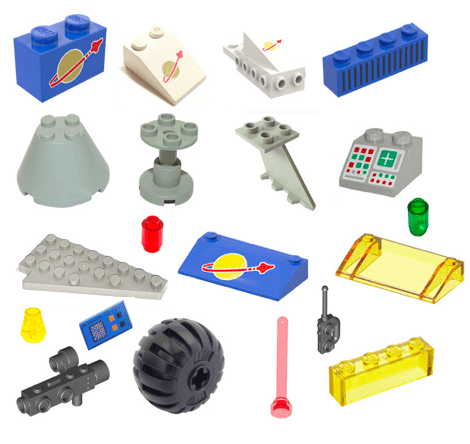
The 4 basic colors that are used in the sets are light grey (also know as old grey), blue, white and in lesser amounts black. Every now and then the color yellow was used for things like chairs and in only an odd set there is a red element. The transparant colors yellow, blue and green were used for windows and roofs as well as many different smaller transparant parts (red, yellow, blue and green) for accents and a real off world vibe! So if you see a bunch of lego like below…it can only be a classic space set.
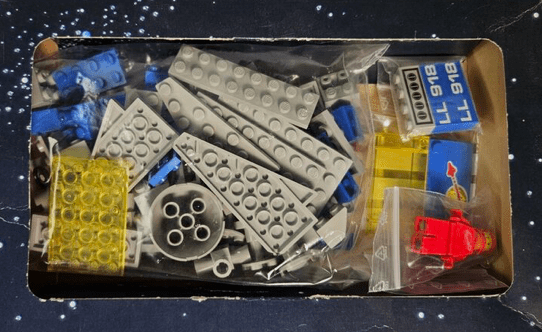
Minifigs and droids
Did you know the droids are often referred to as minifigs! Love that little guy. It came with the set 6931 but is made up of more generic parts. I had a few made to share for the celebration of my 2000th item added to this website and also showing below.
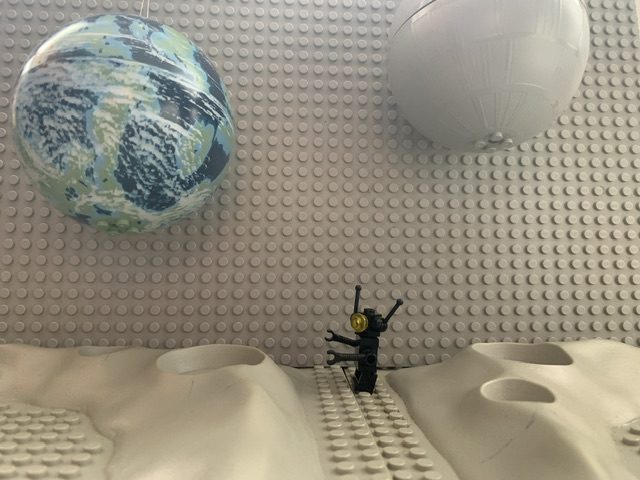
It is just one of the many quirky things that makes Lego Classic Space so awesome! Below a picture of several of my favorite guys and droids from lego classic space.
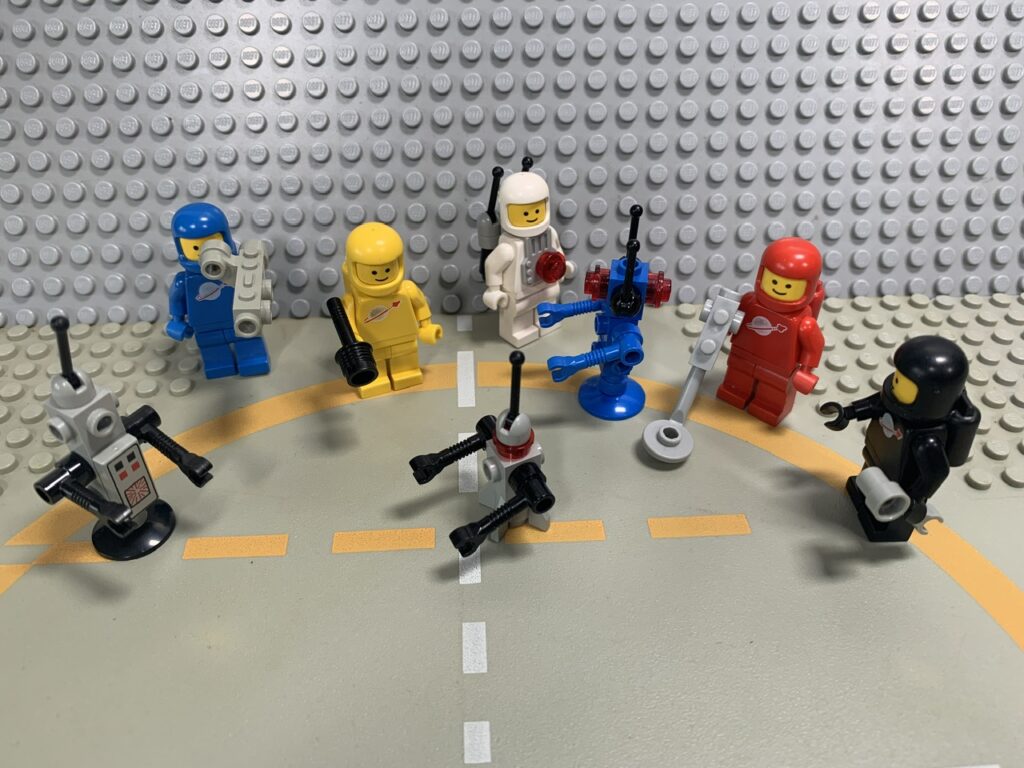
If you like to see a the complete list with all the different details like jetpacks and even the ones with a sticker on their torso and later reeditions please see the list provided by brickset.com.
Different lego classic space baseplates.
The baseplates for Lego Classic space measure 32×32 studs. They started their live as light grey / old grey but you can find them in every tone between light grey and brownish grey. Most baseplates were used, laid flat and played upon. It takes only a few weeks in normal UV licht to get them changing color little by little. So when putting separate bought plates together often lead to some color differences. There are only a few different base plates for Lego Classic Space by number.
305 – 2 crater plates, same as 453
306 – set of 2 landing plates. 1 T-crossing road plate + 1 crossing with round landing plate (Lego ID 6099p05), only 1 of 4 roads have yellow stripes besides them, crossing into the circle (2x 5 yellow dashes inside the circle) Also in set 928 aka 497.
453 – 2 crater plates same as 305
454 – set of 2 landing plates. 1 T-crossing road plate + 1 crossing with round landing plate (Lego ID 6099p03), all 4 roads have yellow stripes besides them, not crossing the circle (2x 4 yellow dashes inside the circle). This plate also came with set 6980 the Galaxy Commander.
And then there is a 3rd landing pad (Lego ID 6099p06) where only 1 roads has yellow stripes besides them, not crossing the circle (2x 4 yellow dashes inside the circle). It is not clear to me where this one came in.

All different lego classic baseplates shown above, with many thanks to the Lego Studio software provided by Bricklink (Lego-owned). Technically there is one more:
3811 – light grey flat base plate, produced from 1978 up until 2000. Used in the set 493-1 Space Command Centre (1978) which was renumbered in 926 in 1979 and then came with a crater plate.
Top 4 Things that effect the collectability of a Lego set
The most important Lego classic space collecting information is about the top 4 things that affect just how collectable a set is. Which is about the same as the price point and how hard anybody would like to own such a set. They are from most important to less important:
- Box present
- Instructions present
- Overall Condition
- Originality and completeness
I will explain these in full, one by one, below.
1. Is there a box present?
It is as simple as this. The box is worth money on it’s own. For every 20 or so set’s out there only one 1 box remains. Only 1 in a 10.000 sets (probably even less) has stayed in the box unopened. These sets demand the highest prices…although it completely escapes me why anyone would like to buy a set in order NOT to play with it. But let’s say it is an interesting investment. So having a box is always worth extra money.
2. Is the instruction sheet / manual present?
You can download building instructions from the internet. But it easier and more 1980’s to have the original manual / stap by stap instruction sheet. This sheet completes the set and is also an indication that the set has been saved / respected / held together and that the set was not made up of random pieces. But hey…it is still lego so no guarantees ever.
3. What is the condition of all the parts and minifigs?
Having the box and manual is one thing. The condition it’s in also counts. Some boxes were cut in pieces, so not counting as a box at all, just nice to haves. What I find about boxes is that they can have:
- storage marks such as scratches or stains,
- a corner can be damaged,
- it can be repaired or can even be folded.
- it can only be a partial box for instance only the sleeve and not the inner box,
- the inner box can be missing the inlay.
Then there are the manuals or instruction sheets or booklets, these are pretty straight forward but you better ask for pictures of all the page because any instruction sheet can have the following issues:
- can have tears from frequent use over the folds
- tears in different places or a small piece missing
- many folds since it seems hard to fold an instructions sheet correct (see picture below)
- writing in it or stains,
- whole pages can be missing (mostly the last or middle one)
- punch holes (which often means they are kept well in a binder, so this could also be a plus)
- (bad) repairs, often with tape gone yellow.
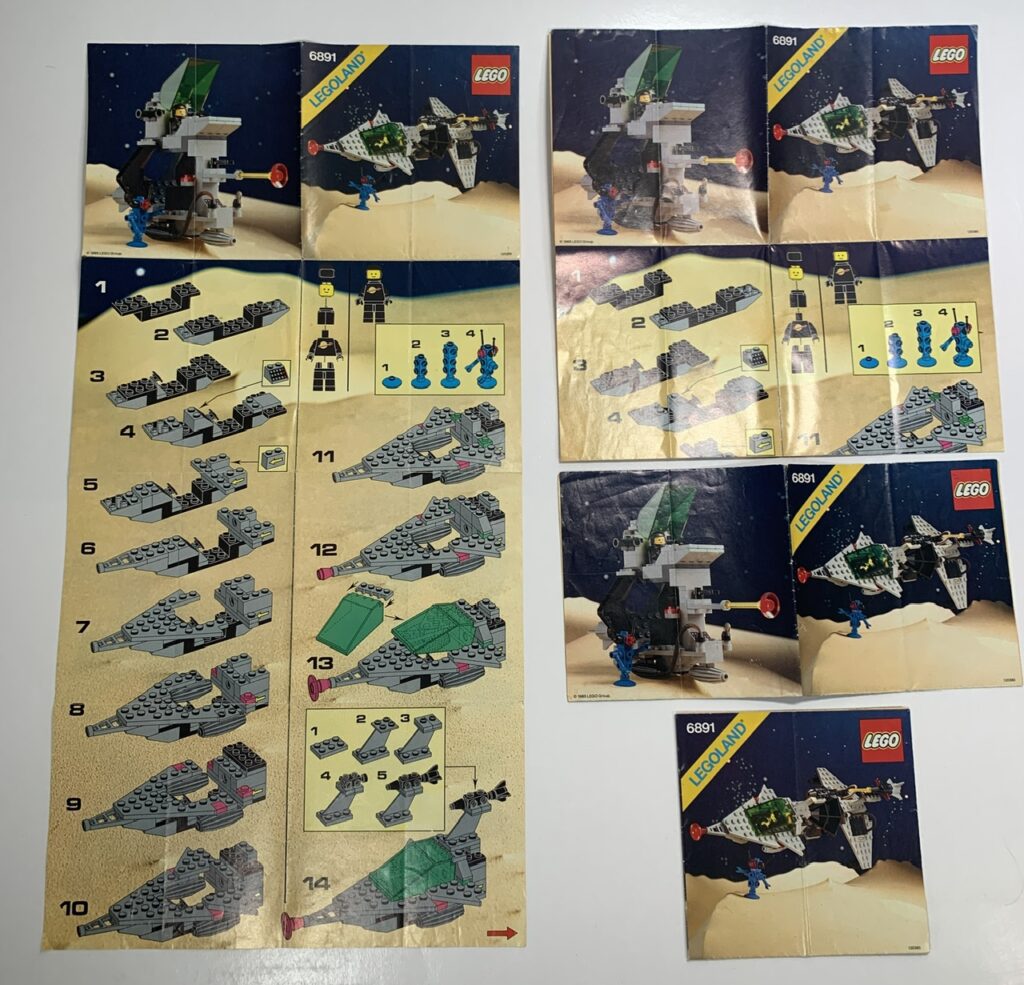
How to fold a lego instructions sheet
The set itself can look good in the picture in a first glance but when you have it in your hands you can could be confronted with any of the follow issues:
- dust and or dirt and sand between the wheels,
- discoloration from dust (over time and under bad conditions, the dust may react with the plastic),
- cracks in regular parts like hinges, radar dishes, grapplers or inner wheels
- heavy scratches or cracks in transparent parts, mostly windows or bases that go over studs
- faded logos and prints on special elements
- One side or any random number of elements can be discolored from the sun
About discoloration I can add that some batches discolored easier. Blue pieces that had to endure stress from trapping for instance can have a different plastic mixture and therefor be lighter see my post on Vintage space lego – preparing before sale process, that also covers the art of color matching.
Always look closely at the minifigs because I have seen some interesting anomalies like:
- Face has been (partially) rubbed off
- gold of the moon can be (partially) rubbed off or most of the entire logo
- bite marks can be found on all parts including neck
- broken chin strap
- loose parts (mostly head or helmet falling off)
- discoloration in many degrees (mostly white and blue astronaut)
- the yellow of the yellow spaceman hands and air tank are not yellow but much lighter
Below a lineup of the different conditions (also from discolored (left) to pristine on the right.
4. Originality and completeness : are all (the right) pieces included?
Every Lego element has it’s own identifier in a 4 digit number, so the same layout as the set numbers but there are no doubles. Newer pieces and sets get numbers with 5 digits. Even when an element has gotten redesigned over time it keeps the same number. The digits point towards the shape (including small changes).
The color though is not indicated by the 4 digits! This seems where many people go wrong. Specially since the grey color of lego classic space is both referred to as “old gray” as well as “light grey”. All other gray colors like dark gray, stone gray and blueish grey are different. So beware of elements with just the wrong color. To name a few, I have seen red antennas instead of transparent red, transparent neon green instead of transparant yellow and very often the same part but without the print (who cares…right?). Also computer can be mixed (type screen versus buttons + cross).
When people order new parts to complete a set before sale, they do not really look all that close. But most collectors do. Below there are 2 pictures showing elements often found in Lego Classic Space sets (left side) and their newer counter parts (right).
The reason for redesign are often to enforce the element, for instance the blue stand below has gotten a thicker front. The clip in the right picture got fatter but also am adjusted shape (from ‘o’-clip to ‘u’-clip). Most redesign make the original piece more versatile so it can be used for more creativity. Like in the black and white cones holes were added so you can attach different elements. For better and longer lasting grip (and probably the saving of material used) the top richt 1×4 plate (and many other basic elements) got a redesigned bottom. It does not really distract from the end result (build set) but for the purist and collector it might just not feel correct and thus have an influence on collectability.
When looking at the spaceman it is good to know that new redesigned spaceman and droids were introduced in the 2000’s, which are shown in the list referred to under “minifigs and droids” above. Other then that minifigs can have
- Later motor cycle helmet with place for visor (there are about 4 different original ones incl. dimples)
- later heads (not the normal simple smile)
- missing air tanks or jetpack (hard to find item) or even a helmet or hand
- wrong tools, wrong color tools
- transparent sticker on torso instead of print, yet this could be original for very early spacemen!
And of course there can always be parts missing. These are often parts that get misplaced easily, here is what to look for in a set when you prefer to be complete (every part missing can be a costly search).
- Your space man can miss a tool, either in hand or on the vehicle (sometimes not shown clearly in instructions)
- the small yellow “mining” parts often 1×1 plate elements
- some sets have losse addition 1×2 plates with an arrow
- all kinds of 1×1 transparent round or square bricks with open stud top
- antennas are most often missing
- hoses can be broken or torn and therefor discarded
- space stands seems to be missing often under command stations or space ships
- the elements that needed to be added in the last picture of the instruction manual
If you want to know more about all this, do read my post about vintage lego classic space condition and grading.
Is vintage Lego Classic Space a good investment?
There are several reasons why I expect that the sets from the Lego Classic Space range produced between 1978 and 1987 will be a good financial investment. I believe that in the coming decades the value of these set will go up in value. These are the reasons.
First of all because the Classic Space range marked a pivot point in Lego history. I can recommend reading the book:
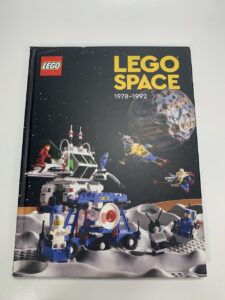
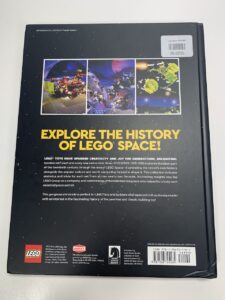
Published in 2023 and readily available (still). Introduction and first chapter covers the Lego Classic Space range until 1987, this is about 100 pages.
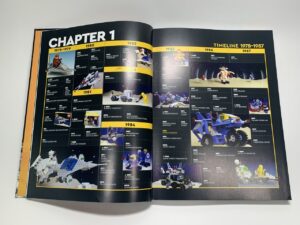

The second reason is the fact that the classic space range was the original range, the first real range in Lego space sets, followed by several other ranges to build on this. Amongst these ranges were Futuron, Space police, Blacktron and M-Tron up until 1992. But later there were other sub themes like Lifo on Mars and exploriens with a great commemorative set in 2022 (set 10497) which is a reedition of the original classic space set 928 from 1979 including the droid from set 6809 from 1987 and several original one color spaceman used in the sets from 1978 unto 1987.
The third reason is that the kids from 1978 and onwards are now getting into their 40’s and 50’s the age that they are looking back at their life and start collecting pieces of their childhood that gave them most of their fond memories. I am pretty sure the classic Lego smile was part of that and for many the classic smile of the classic spaceman!
The fourth reason is that Lego is very collectable. The sets are well documented in the original lego books but also in their instruction sheets. Besides that, there are various websites that show the sets in great detail, amongst these are Brickowl and Toysperiod. And of course they look great on display. If you are planning on doing so, make sure to read my article on Lego Classic Space maintenance and storage.

The fifth reason goes for all Lego sets. Lego is just highly enjoyable and therefore very nice to have around and invest in. You can play with it time and time again and share it with the new generations, while it still captures the imagination and provides the same look and feel as it did back then.


